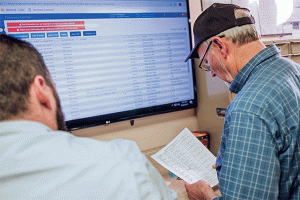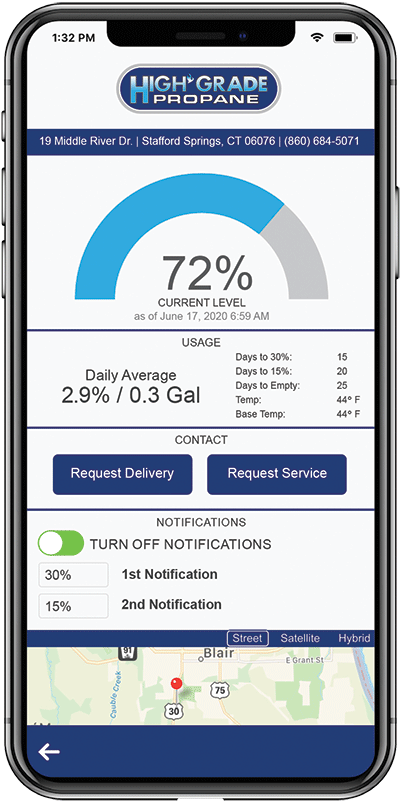New frontiers: Propane leaders use technology to advance operations
With the new year upon us, many propane marketers may be asking themselves, with renewed focus, what growth looks like for their companies in 2023.

Propane retailers are paying close attention to the new technology available for their operations. (Photo courtesy of Cargas)
For Chelsea Aiken of High Grade Gas Service, Kara Tucker of Koppy’s Propane and Matt Brock of McAdams Propane, technology is central to that vision of growth – though each leader is at a different stage in the journey to find the right technological tools for their operations.
As a third-generation member of the Aiken family, which founded High Grade Gas Service in 1957, Aiken says she occupies “that generational gap” between how her father ran the business in the past and how she plans to run it moving forward.
Over the past three years, High Grade implemented several thousand tank monitors, as well as a new website and software system that enables customers to order gas, pay bills and access account history online. Energy Distribution Partners acquired the company, based in Stafford Springs, Connecticut, in November 2022 and promoted Aiken to general manager.

Aiken
“There’s that very fine line you walk between learning and teaching,” Aiken says of her role in the business’s transition to technology.
Kara Tucker, fourth-generation president of Koppy’s Propane in Williamstown, Pennsylvania, understands that fine line. The company adopted tank monitoring about 10 years ago, and Tucker attests to improvements in the reliability and affordability of the technology since then. Now, the company is putting monitors on almost all of its commercial and agriculture accounts and working toward placing them on as many residential accounts as possible. That process has ramped up over the past three years, notes Tucker.
In 2018, Koppy’s also invested in its back-office software to expand use of technology to more areas of the business. Virtual documentation through the software now allows the company to run paperless, and a mobile application that interfaces with the software enables customers to check in on their accounts.
Prior to joining McAdams Propane of Center, Texas, in March 2021, Matt Brock specialized in tank monitoring at Bergquist. That expertise proves useful in his role as director of operations for McAdams. Brock says he spends two to three hours daily “overlooking, discussing and putting plans into action on every ‘techy’ thing we do.”
And the company does a lot with technology. It uses tank monitors on its keep-full accounts and bulk storage tanks, an integrated back-office system, a mobile application, vehicle cameras, a driver qualification program and even an online task management system.
These leaders report gains in efficiency, customer service and other key business measures as their companies have implemented new technologies. But they also reveal the effort behind those strong metrics – to ask the right questions about their businesses and the technologies, to plan for implementation and execute it successfully, and to help customers and employees adjust to change.
Plan the route
Tucker and her team took a hands-on approach when researching the company’s back-office software several years ago. They looked for user friendliness, reliability and, most importantly, references.

Tucker
“The most important aspect of our research when making this decision was visiting other companies that used that specific software and actually sitting down with the people who are using it every day and how it has impacted their day-to-day work,” says Tucker.
During those visits, team members could speak at length with industry peers who used the software, experience the user interface for themselves and inquire about the pros and cons.
Those conversations brought clarity to the decision, says Tucker.
She advises marketers to tap into their network of industry colleagues or ask the technology vendor to provide references local to their propane operations.
At the same time, marketers should consider whether a new technology suits the unique attributes of their business because technology products are not one-size-fits-all, suggests Brock. He explains that when McAdams first looked into tank monitors, the product had to work for a remote, rural customer base that didn’t always have strong cellular coverage – a condition that may not apply to every propane operation.

Brock
Cost also plays a major role in the deliberation, adds Brock. He sums up the cost-benefit analysis of any technological decision with a question: “Is the juice worth the squeeze?”
Companies have to weigh the investment of money, time and labor to implement the new technology against expected gains in efficiency, a metric that in itself requires some effort to track, at least initially.
“Nine times out of 10,” says Brock, “if we bring something to the table, the juice is typically worth the squeeze.”
High Grade appears to have squeezed plenty of juice from its investment in tank monitors.
When the company was researching the technology, it was seeking a way to cut costs on deliveries to intermittent gas users, says Aiken: “The first step was: This is what we’re paying our on-call guys to go out and service these folks on the weekend or after hours when they run out. So when you sat down and put numbers together, [the savings were] going to far outweigh the costs of servicing these folks.”
She estimates that, with tank monitors, the company has eliminated about 300 stops a month and achieved a tenfold savings, outweighing the initial cost of the monitors.
Avoid roadblocks
For Aiken, the most challenging part of the implementation process was placing into service as many tank monitors as she did in a year’s time. She credits the bobtail drivers who installed the monitors while maintaining their usual delivery routes for the quick transition.
“During setup, it’s pretty crucial that you stay organized,” she says. “There’s a lot of data input to get every one of [the monitors] set up. They were long hours – I’m not going to lie about it – but in the end, it was all toward our benefit.”
As in any endeavor, she adds, problems and mistakes happen, but marketers shouldn’t let that deter them from developing a sound implementation plan.

High Grade Gas Service plans to introduce a cellphone app for its customers in 2023. (Image courtesy of Energy Distribution Partners; warmworld – stock.adobe.com)
“Have a plan in place before you jump out and start doing it,” she says. “Even if that plan changes along the way, you’ve got to have some kind of order going in.”
That plan usually involves a pricing structure that supports the growth a company expects to achieve with a new technology.
High Grade offsets any ongoing costs with price adjustments or, in select cases, a monitoring fee, says Aiken.
McAdams also charges a monitoring fee to maintain the service, notes Brock.
When customers criticize a pricing decision, Brock explains to them that the technology is especially valuable “during those busy times, those unsuspecting times when it’s 10 degrees outside, or when you lose power during the snowstorm and your generator is rolling.”
He points to the winter storm of February 2021 that left much of Texas without power for days. During that event, monitors helped the company track unusual propane draws and keep customers full.
After an experience like that, he adds, many customers don’t mind paying an annual fee to ensure a continuous supply of power.
But for the most part, say the leaders, customers enjoy technology-driven improvements in transparency and communication, such as mobile applications or online portals that allow them to check their tank levels. Koppy’s and McAdams currently use a customer-facing mobile application, and High Grade plans to implement one in 2023.
Customers also notice enhanced service when drivers and office staff can access real-time information, says Tucker. For example, if a customer calls and says they did not receive a propane delivery, but the delivery is time-stamped in the account, customer service can immediately troubleshoot if the customer is experiencing a problem with an appliance or another issue.
On the employee side of the business, acceptance of new technologies can prove challenging, at least initially, says Tucker. With Koppy’s back-office software, initial shock waves rippled through the staff for about two months. By four to six months, employees were becoming accustomed to the new day to day. In six to eight months, says Tucker, leadership finally started to hear statements like “Why didn’t we do this sooner? This is amazing.”
Finding a staff member willing to advocate for the change can make a big difference.
“If you get a few drivers who are excited about it, who feel comfortable with the product, they’re going to be able to help the other team members,” says Tucker. “It’s a challenge. Nobody likes change. … Managing that is giving them as much support as you can and also having a few key people within the organization who are really going to champion the new technology.”
It also helps to start small, perhaps with one driver on a single route, and ask for feedback from employees from the very beginning of the process, says Brock. Then, actively listen to that feedback.
“When they have a little bit of say, a little bit of input, I think it goes a long way,” says Brock, “especially if you respond and react, or at least do the due diligence of looking into what they’re questioning or have concerns about.”
Words of wisdom
Here’s what three propane leaders have learned from onboarding various technologies at their companies and what they want their fellow retailers to know about the process.
“Understand that what seems incredibly slow at the beginning will eventually speed up and get easier and get faster.” – Chelsea Aiken, High Grade Gas Service
“Keep an open mind and a positive attitude. If you do the research, you’ll make the right decision, and the outcomes will be very beneficial.” – Kara Tucker, Koppy’s Propane
“Don’t be afraid of taking that tech step forward. And by all means, utilize your industry peers to see what works and doesn’t work for them. Try not to do the same mistakes they made, and capitalize on the good things they did.” – Matt Brock, McAdams Propane
















